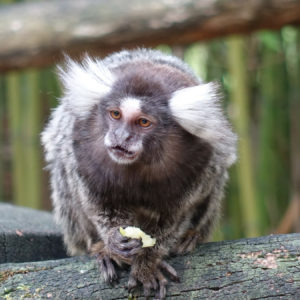Common Marmoset

Scientific Name: Iguana iguana
IUCN (Red List) Status: Least Concern (LC)
Marmosets and tamarins are distinguished from the other monkeys of the New World by their small size, modified claws rather than nails on all digits except the big toe, the presence of two as opposed to three molar teeth in either side of each jaw, and by the occurrence of twin births. Common marmosets are very small monkeys with relatively long tails. Males and females are of similar size, with males being slightly larger. Males have an average height of 188 mm and females have an average height of 185 mm. Males weigh 256 g on average and females weigh 236 g on average. The pelage of the marmoset is multicolored, being sprinkled with brown, grey, and yellow. It also has white ear tufts and the tail is banded. Their faces have black across their nose area skin and have a white blaze on the forehead. The coats of infants are brown and yellow with the ear tuft developing later.
Habitat: Forest, Savanna. An inhabitant of gallery forest, semideciduous and deciduous scrub forest . and humid Atlantic forest of north-eastern Brazil. It is very adaptable, being able to live in urban parks and gardens and rural villages where it is not persecuted and has sufficient food. It has been introduced into many areas outside of its natural range, where it is able to thrive and is believed to compete with and displace other (native) marmosets.
Animal Location: South American Forest
Diet: They eat fruits, flowers, nectar, plant exudates (gums, saps, latex) and animal prey (including frogs, snails, lizards, spiders and insects). Marmosets have morphological and behavioural adaptations for gouging trees trunks, branches and vines of certain species to stimulate the flow of gum, which they eat, and in some species form a notable component of the diet. is a gum-feeding specialist, with gouging lower incisors to excavate holes in gum-producing trees to guarantee gum year-round. This allows it to live in very seasonal habitats
Reproduction: They live in extended family groups of between four and 15 individuals. Generally, only one female per group breeds during a particular breeding season.Usually one female breeds in each group. Twins are produced twice a year.


